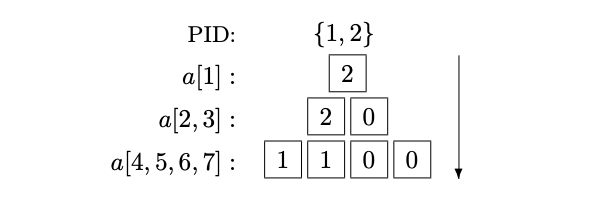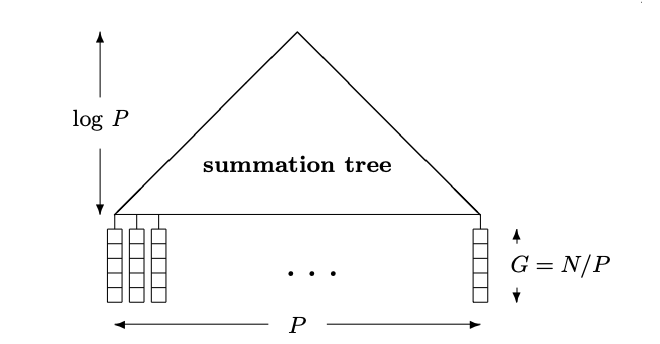PRAM Algorithms
Programming for PRAM
- usual representation is a high-level program that can be compiled into assembly level PRAM instructions
- many techniques exist for compiling such programs → does not affect computational complexity of algorithms
- programs are model independent
parbegin-parendindicate parallel blocks- concurrent executions in sync/async parallel models have differences
- sync will perform concurrent execution
- async will interleave actions in some order
In this example (CRCW PRAM) statements marked with // are executed concurrently

- typically processors are running the same program
- SPMD = single-program multiple-data = model where processors have their on instruction counters and maybe working on different data
Example of SPMD program where each processor executes the sequential Program(pid):
1 2 3 4 5 6 7 8 9 | |
SPMD model requires special attention when dealing with if-else or while-do statements, including precisely defining specific timing of operations for the program to make sense
In example below: - right-hand side is evaluated first, assignment last - pre and post conditions hold - assume identical timing for all instructions
1 2 3 4 5 6 7 | |
Spanning Tree Broadcast
- assume spanning tree with depth
- each processor has a channel to its parent and children
- root
- this algorithm is correct for sync/async systems and message and time complexities are same
for
1 2 | |
for
1 2 3 | |
| Bounds | |
|---|---|
| message complexity | |
| time complexity |
Parallel Tree Traversal
- setup: sync parallel processors with shared memory operating on binary trees
- store tree in an array to create maintenance-free tree:

- complete tree with
- root is at
- any non-leaf at
- use padding if number of children is not a power of 2
- root is at
- This representation can be generalized to
- use bottom-up or top-down traversal of tree
- number of leaves is proportional to size of input
- height of tree is
- traversal takes logarithmic time
- number of leaves is proportional to size of input
Parallel counting example
- example of progress tree often used with divide-and-conquer
- each processor writes into the node in the tree the sum of the two child locations
- root node has final value 3
- PID 1 is not necessary

Progress evaluation example
- Each processor writes 1 into leaf if it finished its task
- sum of children stored in the parent
- when value at root node is

Load balancing example
- two processors start from top
- both proceed to right subtree because left subtree is complete, none on right is complete
- in next step the processors divide equally to

Processor Enumeration Algorithms
- goal: enumerate participating processors
- each uses an auxiliary tree data structure
- each processor can call the algorithm procedure from a high-level program (same for all)
- progress is measured in progress tree
Using clear memory
- assume clear shared memory, i.e. all tree nodes are initialized to 0's
- perform bottom-up traversal to compute number of active processors
- each active processor writes 1 in leaf
- inactive processors do nothing
- enumerate active processors to the left
1 2 3 4 5 6 7 8 9 10 11 12 13 14 15 16 17 18 19 20 21 22 23 | |
Using timestamps
- same as previous with the additional use of timestamps to ensure fresh values
- allows reuse of the same tree over time
- counts that are out of date are treated as 0s
1 2 3 4 5 6 7 8 9 10 11 12 13 14 15 16 17 18 19 20 21 22 23 24 25 26 27 28 29 30 31 | |
Clearing old data
- clear memory before using it
- assume there are no active siblings at any tree node by clearing the subling and writing the new value in current location in c
1 2 3 4 5 6 7 8 9 10 11 12 13 14 15 16 17 18 19 20 21 22 23 24 25 26 | |
Load Balancing
- uses a progress tree
- number processors starting with 1 and refer to this number (instead of pid)
- processors traverse the tree from root to leaf and allocate themselves to left/right subtree relative to incomplete tasks
- at leaf processor computes index
1 2 3 4 5 6 7 8 9 10 11 12 13 14 15 16 17 18 19 20 | |
Broadcast with Tree
- for CREW PRAM for broadcasting value to all processors
- for simplicity assume
- processor PID = 1 will broadcast the value
- for any node in the tree,
- start by having processor 1 write its value to root, then children read the value from their parent progressively
- note concurrent reads → can be modified to have parent push a value to its children to achieve EREW model which does not impact complexity
| Bounds | |
|---|---|
| time complexity | |
| work |
1 2 3 4 5 6 7 8 9 10 11 12 13 14 15 16 17 18 19 20 21 22 | |
Modified version of Divide-and-Conquer method to perform broadcast with tree, where parent pushes value to its children
1 2 3 4 5 6 7 8 9 | |
Optimal Parallel Summation
- this example is for summation but can be applied to any associative operation
- goal: combine optimal sequential algorithm for summation with fast parallel algorithm for summation
- let
- each processor at leaf will compute
- for optimal work, choose parameters such that
Data structure for summation

| Bounds | |
|---|---|
| time complexity | |
| work | |
| speedup |